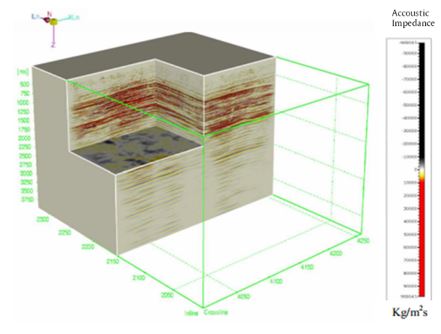An Analysis of the Accuracy of Time Domain 3D Image Geology Model Resulted from PSTM and Depth Domain 3D Image Geology Model Resulted from PSDM in Oil and Gas Exploration
DOI:
https://doi.org/10.25299/jgeet.2019.4.1.2121Keywords:
Geology Model, Time Domain 3D Image, PSTM, PSDM, Horizon Based TomographyAbstract
This study aims to obtain a geological model which is close to the truth and compare accuracy between the time domain 3D image of the PSTM results with the depth domain 3D image of PSDM results. There are 3 parameters to determine the accuracy of an interval velocity model in the production of a geology model: depth gathering that is already flat, semblance that has concurred with zero residual move-out axes, and depth image which conforms to the marker (well seismic tie). The analytical method employed is Horizon Based Tomography, which is a method to correct the seismic wave travel time error along the analyzed horizon. Reducing errors in the travel time of the seismic wave will decrease depth errors. This improvement is expected to provide correct information about subsurface geological conditions. The results showed that the depth domain image generated by the PSDM process represents the actual geological model better than time domain image produced by the PSTM process, evidenced by the sharpening of the reflector continuity, reduction of pull-up effect, and high resolution.
Downloads
References
Guo, N. and Fagin, S., 2002. Becoming effective speed-model builders and depth imagers, Part 1—The basics of prestack depth migration. The Leading Edge, 21, 1205-1209.
Hill, N.R., 2001. Prestack Gaussian-beam depth migration. Geophysics , 66, 1240 -1250. https : //doi.org/10.1190/ 1.1487071
Irawan, S. and Khoirunnisa, H., 2017. Identification of Reservoir Thickness and Estimation of Hydrocarbon Reservation used the Pre-Stack Depth Migration (PSDM) in Cikung Area. Journal of Applied Geospatial Information, 1, 5-10.
Irawan, S., Sismanto, Sukmatiawan, A., 2014. Applying the Horizon Based Tomography Method to Update Interval Velocity Model, Identify The Structure of Pre-Stack Depth Migration 3D and Estimate The Hydrocarbon Reserve In SBI Field of North West Java Basin. Jurnal Teknologi, 69, 53-58.
Mittet, R., Sollie, R. and Hokstad, K., 1995. Prestack depth migration with compensation for absorption and dispersion. Geophysics, 60, 1485-1494. https://doi.org/10.1190/1.1443882
Purnawati, L. and Minarto, E., 2016. Koreksi Struktur Lapangan “LP” dengan Menggunakan Metode Pre Stack Depth Migration (PSDM). Jurnal Sains dan Seni ITS, 5.
Shin, C., Jang, S. and Min, D.J., 2001. Improved Amplitude Preservation for Prestack Depth Migration By Inverse Scattering Theory. Geophysical prospecting, 49, 592-606. https://doi.org/10.1046/j.1365-2478.2001.00279.x
Stolk, C.C. and Symes, W.W., 2004. Kinematic artifacts in prestack depth migration. Geophysics, 69, 562-575. https://doi.org/10.1190/1.1707076
Yilmaz, Ö., 2001. Seismic data analysis: Processing, inversion, and interpretation of seismic data. Society of exploration geophysicists.
Washbourne, J.K., Tomoseis Corp, 2001. System for eliminating headwaves in a tomographic process. U.S. Patent 6,269,310.
Woodward, M.J., Nichols, D., Zdraveva, O., Whitfield, P. and Johns, T., 2008. A decade of Tomography. Geophysics, 73, VE5-VE11. https://doi.org/10.1190/1.2969907
Zhou, J., Birdus, S., Hung, B., Teng, K.H., Xie, Y., Chagalov, D., Cheang, A., Wellen, D. and Garrity, J., 2011. Compensating attenuation due to shallow gas through Q tomography and Q-PSDM, a case study in Brazil. In SEG Technical Program Expanded Abstracts 2011, 3332-3336. Society of Exploration Geophysicists.. https://doi.org/10.1190/1.3627889

Downloads
Published
Issue
Section
License
Copyright @2019. This is an open-access article distributed under the terms of the Creative Commons Attribution-ShareAlike 4.0 International License which permits unrestricted use, distribution, and reproduction in any medium. Copyrights of all materials published in JGEET are freely available without charge to users or / institution. Users are allowed to read, download, copy, distribute, search, or link to full-text articles in this journal without asking by giving appropriate credit, provide a link to the license, and indicate if changes were made. All of the remix, transform, or build upon the material must distribute the contributions under the same license as the original.










